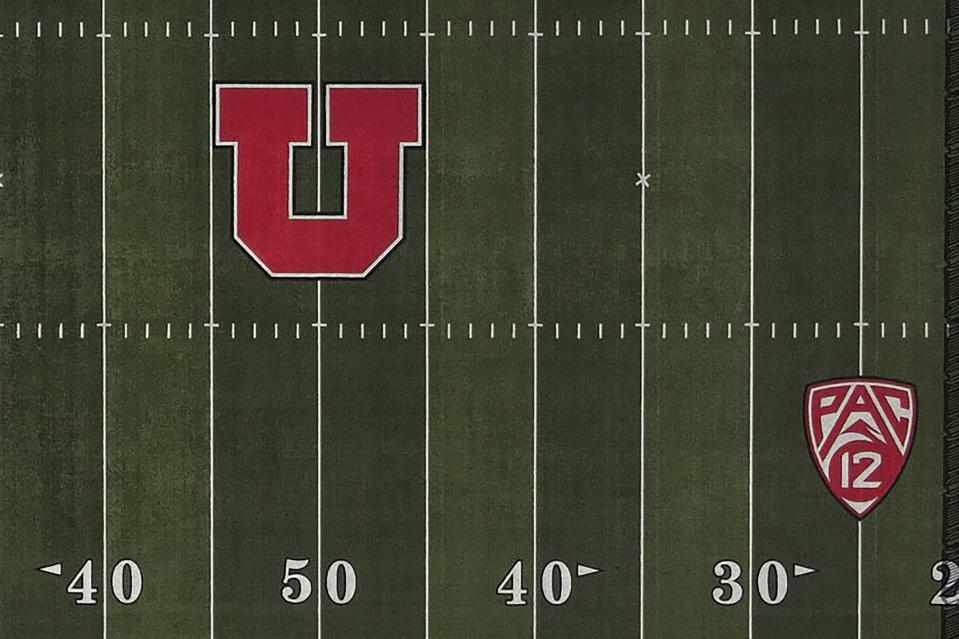Utah bids farewell to the Pac-12 era, which saw its football program rise to national prominence
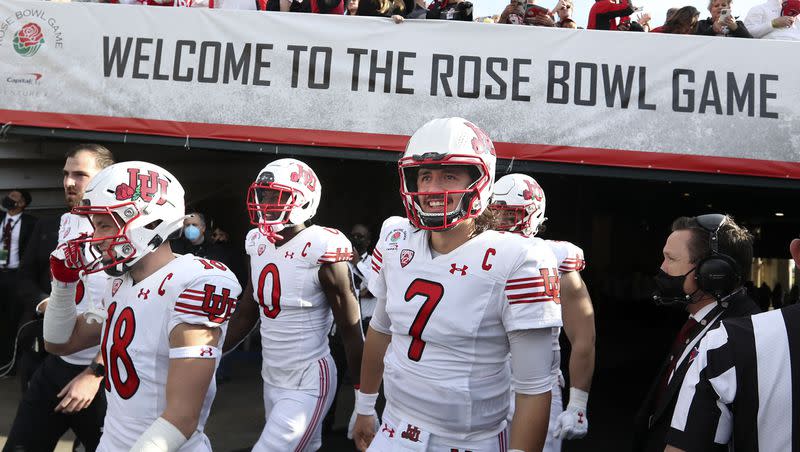
- Oops!Something went wrong.Please try again later.
- Oops!Something went wrong.Please try again later.
It’s easy to see why Utah fans will mourn the demise of the Pac-12 Conference.
When official word came down that the Utes would join the conference in June 2010, it set off celebrations throughout the fan base. Utah fans likened it to the joy of the holiday season, dubbing it “Pac-mas.”
“Today is an absolutely great day to be a Ute,” athletic director Chris Hill said at a press conference announcing the move.
A year later, when Utah was welcomed into the newly-renamed Pac-12, Utah Lt. Gov. Greg Bell declared July 1, 2011, “Pac-12 Day” in the state of Utah. Apparel co-branded with Utah and Pac-12 logos sold like hotcakes.
Utah’s addition to the Pac-12 was the pronouncement that the Utes had finally arrived in the college football world.
Utah had eaten at the “big boy table” twice before, winning BCS bowls during their undefeated 2004 and 2008 campaigns, but was never afforded an opportunity to play for a national championship. That would no longer be the case with the Utes in a Power Five league. If Utah went undefeated, they’d get a shot at the title, especially when the College Football Playoff was introduced in 2014.
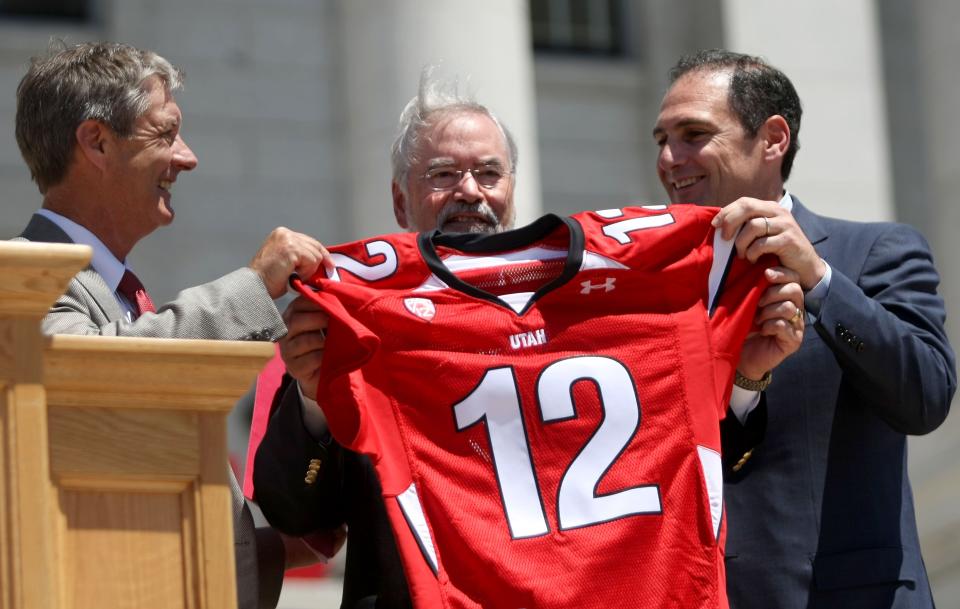
During the first couple of years, teams like USC and Oregon rolling into Salt Lake City for conference games felt like pinch-me moments, especially for longtime fans that sat through plenty of losing seasons.
In its first year in the conference, Utah came extremely close to making it to the Pac-12 championship game. A win over Colorado in the 2011 regular-season finale, combined with a UCLA loss to USC (the Bruins lost to the Trojans the next night), would have clinched a title-game appearance since USC was ineligible for the championship game due to sanctions from the Reggie Bush scandal, which is quaint to look back on in this age of NIL. Utah kicker Coleman Petersen missed three field goals in a 17-14 loss, dropping the Utes to 7-5.
Utah beat Georgia Tech in the Sun Bowl to cap off a respectable first season in a Power Five league, but would hit a wall in its next two seasons. The Utes may have had good talent in the Mountain West Conference, but needed to raise their recruiting level to a Power Five standard.
Growing pains were apparent in 2012 and 2013, a pair of 5-7 seasons, Utah’s first consecutive losing seasons since 1989-1990.
“There was some tough sledding early, there was a transitional period in some respects, not in every respect,” Utah coach Kyle Whittingham said Monday. “We came into the league fully equipped in the line of scrimmage to compete, but not in the perimeter. Took a few recruiting classes to get the roster where we needed it to.”
But the tide was turning.
Upping its talent
Utah’s Power Five membership was allowing it to recruit the caliber of player it needed to succeed in the week-in-week-out grind of Pac-12 football. The 2011 class was ranked No. 6 in the conference (per 247Sports), 2012 was No. 8, 2013 was No. 9. Utah wasn’t pulling in five-star recruits, but was steadily upping its talent pool and the coaching staff was hard at work developing those players.
The Utes hit a tipping point in the 2014 season, winning nine games, and have finished with a winning record every year since.
Related
The recruiting hauls would continue to improve just about every year as well, and the Utes signed their highest-rated class ever in 2023, ranking No. 20 in the country, according to 247Sports.
“It says that our brand is becoming stronger. We are building the brand year by year and we are getting in just about every single door that we want to get in,” Whittingham said in 2021. “Now we aren’t getting all of the players, obviously you still need to battle and get them signed, but we are getting in doors every year and it’s getting to the point where there is almost no door that we can’t at least get in and get some interest from the player. Our name is just starting to be much more prominent out there.”
After crushing late-season defeats year after year denied the Utes a trip to the elusive Pac-12 championship game, Utah finally got over the hump in 2018, winning the Pac-12 South division. Without quarterback Tyler Huntley and running back Zack Moss, out with injuries, the Utes lost a 10-3 heartbreaker to Washington in San Francisco in Utah’s first trip to the Pac-12 championship game.
In 2019, with a veteran team back, Utah put together an 11-1 campaign to get back to the Pac-12 title game. A playoff berth may have awaited if No. 5 Utah could have defeated No. 11 Oregon, but the Ducks dominated the Utes in the trenches and cruised to a 37-15 win.
Pac-12 champs
Those heartbreaks and setbacks made it all the sweeter when Utah, led by quarterback Cam Rising, reached the Pac-12 mountaintop two seasons in a row.
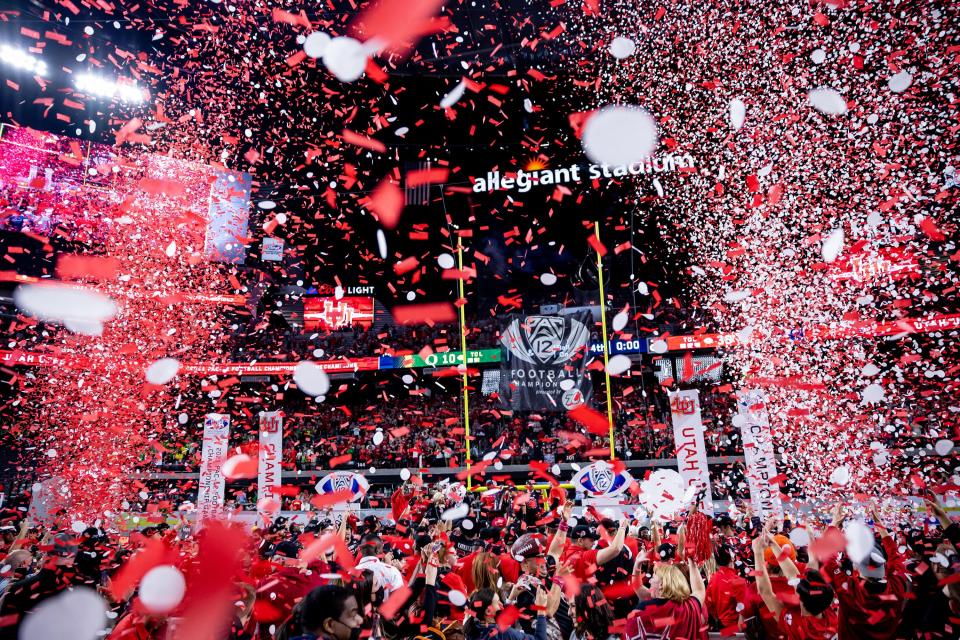
Utah captured its first Pac-12 title in 2021, beating Oregon twice — once at home, once in the championship game — to punch its ticket to the school’s first-ever Rose Bowl.
The Utes did it again in 2022, this time taking down USC in the Pac-12 championship game after four results went Utah’s way on the final weekend of the regular season to get back to the title game.
By the end of it all, the Utes went from being the plucky newcomer to one of the Pac-12’s most respected teams. Utah was one of four schools, along with Oregon, Stanford and Washington, to win multiple conference championships during the Pac-12 era.
“I’d say it turned out as good as we could have hoped it to turn out,” Whittingham said.
Whittingham has overseen Utah’s rise from the Mountain West to Pac-12 champions. He masterfully guided the Utes through the Power Five transition, molded the program into a “tough and physical” brand, and slowly but surely built a national power.
The only thing that would have made Utah’s run better would have been a win in the Rose Bowl or a College Football Playoff appearance.
Power Five impact
It’s almost impossible to overstate just how impactful Utah’s time in the Pac-12 has been for the football program, athletic department, university and fan base.
The $1.2 million per year in television rights money from the Mountain West Conference transformed to $21 million per year from the Pac-12 Conference, which was a record-breaking TV rights deal at the time.
Donations from boosters increased upon Utah’s arrival in the Pac-12, and in 2013, the $32 million, 150,000-square-foot Spence and Cleone Eccles Football Center opened, providing the football team with a state-of-the-art facility.
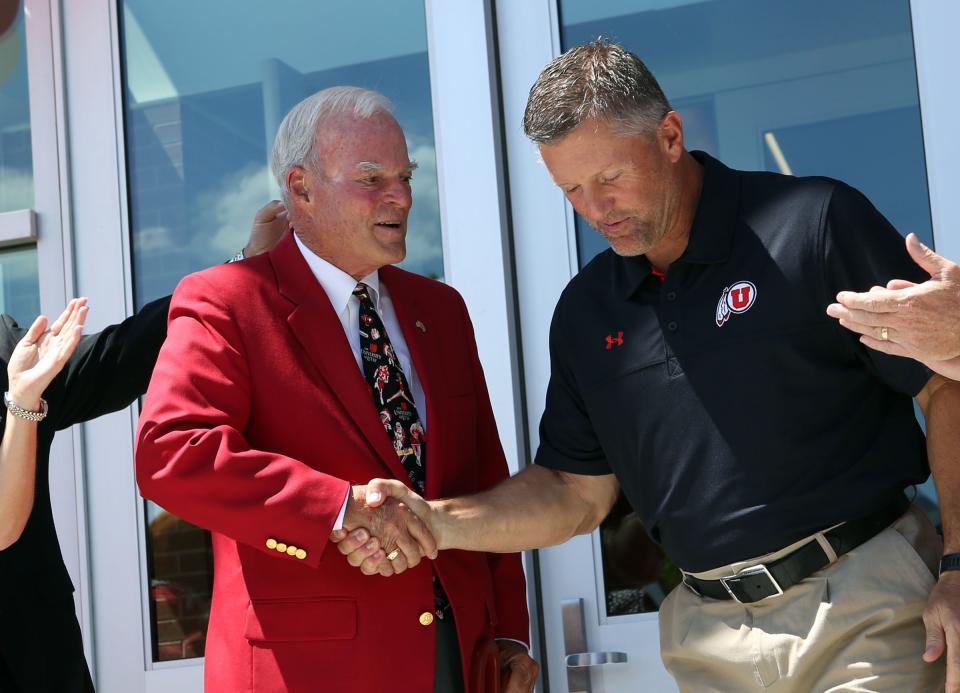
Rice-Eccles Stadium has enjoyed an 82-game sellout streak, and added 5,637 more seats and new locker rooms in a 2021 south end zone renovation. Season tickets have been sold out for the entire Pac-12 era and in 2022, the football program made a profit of $35.7 million.
The architect of Utah’s success, Whittingham has been rewarded handsomely with a $6.83 million per year average salary in his latest contract.
Academically, the university benefited from the Pac-12 Conference, seeing increases of hundreds of millions of dollars in research funding alongside the benefits of being partners with prestigious universities like Stanford, Cal and UCLA.
“Pac-12 was instrumental in building the program, not just beneficial,” Whittingham said. “Having that Pac-12 moniker on your shirt and that conference affiliation ramped up everything in this program — facilities, recruiting, budget, salaries, everything. Making the move to Power Five was a game-changer for the program, for the university, for the community, in my opinion.”
For fans, a conference with 12 teams on the West Coast made travel enticing. Big-time venues like the LA Memorial Coliseum, Autzen Stadium and Husky Stadium, combined with Los Angeles, the Oregon Coast, Seattle and the Bay Area as travel destinations, meant there was always a large contingent of Utah fans at every road venue.
Utah fans can recall exciting games between the Utes and each one of the other 11 schools, and Utah developed memorable series with USC and Oregon in particular.
It seemed like Utah had found a good conference home.
Goodbye Pac-12, hello Big 12
But just as it did in 2010, the conference realignment gears started turning.
It started with Texas and Oklahoma bolting from the Big 12 to the SEC in 2021. That move triggered the Big 12 to add BYU, UCF, Cincinnati and Houston that same year. In 2022, the Big Ten got into the superconference arms race by swiping USC and UCLA from the Pac-12.
Without the giant Los Angeles TV market and two marquee programs, the value of the Pac-12’s next media deal shrunk. Then, Big 12 commissioner Brett Yormark beat Pac-12 commissioner George Kliavkoff to the media deal punch last fall, securing a nearly $2.3 billion media deal with ESPN and Fox that reportedly will pay out $31.6 million per year to each of its schools when it takes effect in 2025.
Related
Kliavkoff, who had turned down a $30 million per school per year offer from ESPN early on in realignment, scrambled for a deal. TV networks had plenty of inventory with the SEC, Big Ten, Big 12 and ACC, and weren’t interested in ponying up more for the depleted Pac-12. The best the conference could muster up was primarily an Apple TV streaming media deal, which offered less base money than the Big 12’s linear TV deal.
After that deal was presented, it was every school for itself.
It was a long process to get here, full of a decade of mismanagement by Larry Scott and Kliavkoff, TV networks seemingly pulling the strings in college athletics, plus some good old-fashioned greed, but in what felt like a blink of an eye, the 108-year-old Pac-12 Conference disintegrated.
“After this game’s over with, the Pac-12 is over with, it’s sad. I’m not going to try to spin it any other way. The conference has been around as long as they have and it’s been successful and had so many championships across so many sports. It’s too bad to see it go away, but it is, nothing you can do about it.” — Utah coach Kyle Whittingham
Oregon and Washington left for the Big Ten; Utah, Arizona, Arizona State and Colorado (the Buffaloes actually left before the Pac-12’s Apple TV deal was presented) took off to the Big 12; and Cal and Stanford eventually signed with the ACC.
Three Pac-12 schools will join Utah in the Big 12, and the Utes will reignite the rivalry with BYU, plus face an old Mountain West foe in TCU. But for the first time in school history, Utah moving conferences is, at best, a lateral move (at least in football; the Big 12 currently boasts the best basketball conference in the country).
There was no “Big 12 Day” proclamation, no exuberant celebrations from the Utah faithful, and I haven’t seen any Utah Big 12 stickers on cars yet.
The reaction from the majority of the fan base was mostly a sigh of relief that Utah had found a landing spot (something not afforded to Oregon State and Washington State), mixed with sadness at the death of the Pac-12.
“After this game’s over with, the Pac-12 is over with, it’s sad. I’m not going to try to spin it any other way,” Whittingham said. “The conference has been around as long as they have and it’s been successful and had so many championships across so many sports. It’s too bad to see it go away, but it is, nothing you can do about it.”
Looking ahead to the Big 12, there’s still opportunity for Utah to continue its upward trajectory.
The Big 12’s TV payouts lag far behind the two most prominent conferences, the SEC and Big Ten, but will pay out more than the Pac-12’s old — or proposed — deal would have, and the Utes will still play on big TV networks like Fox, ABC and ESPN.
If Utah can win the Big 12 Conference, with the current 12-team playoff structure, it would be guaranteed a spot in the College Football Playoff.
Utah has a built-in rivalry with BYU in the Big 12, and will continue the series with at least two of Arizona, Arizona State and Colorado every year. They’ll play old Mountain West foe TCU three out of the next four years, and in time, will have fun back-and-forth series with other Big 12 opponents.
Utes on the air
Utah (7-4, 4-4 Pac-12)
vs. Colorado (4-7, 1-7 Pac-12)
Saturday, 1 p.m. MST
Rice-Eccles Stadium
TV: Pac-12 Network
Radio: ESPN 700/92.1 FM
“You just got to keep moving forward. I’m a guy that can really adapt to change just like that. I’m not a guy that thinks backwards or looks in the rearview mirror. Everything’s in front of me and moving forward. ... You embrace the future and get ready for the next challenges,” Whittingham said.
On Saturday, when Deion Sanders and the Colorado Buffaloes visit, the Rice-Eccles Stadium field will be emblazoned with the Pac-12 logo for the final time.
Fittingly, Utah’s final regular-season game as a member of the Pac-12 will be played on the week of Thanksgiving. Following its most successful decade in history, in no small part due to being a member of the Pac-12, the Utah football program has a lot to be thankful for.
